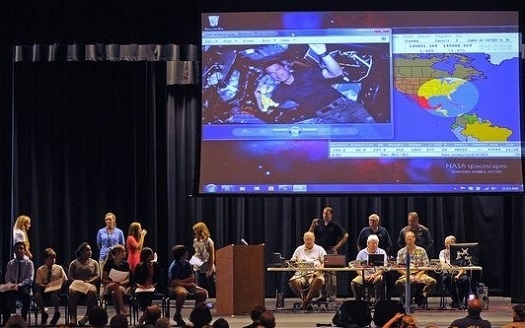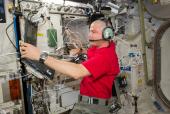ARISS Opens Windows of Opportunity Twice a Year
Two times a year (spring and fall), the ARISS-US Team opens windows of opportunity for accepting education proposals from US schools and education groups. The best proposals are chosen for ARISS scheduled ham radio contacts. For details, please go to here.
Scroll down this page to find a Proposal Guide, the Proposal Form and other information you'll need to apply. Information sessions are offered. Scroll down for dates and times.
Hosting an ARISS Contact
A scheduled ARISS contact is a voice-only communication via Amateur Radio between the International Space Station (ISS) crew and classrooms and communities. ARISS contacts allow education audiences to learn firsthand from astronauts what it is like to work and live in space. These scheduled contact  opportunities are offered to formal and informal education institutions and organizations, individually or working together. The radio contacts are approximately 10 minutes in length due to the radio communication window permitted by the logistics of orbital passes of the ISS. During the contact, students interact directly with astronauts and cosmonauts during this communication window using a question and answer format.
opportunities are offered to formal and informal education institutions and organizations, individually or working together. The radio contacts are approximately 10 minutes in length due to the radio communication window permitted by the logistics of orbital passes of the ISS. During the contact, students interact directly with astronauts and cosmonauts during this communication window using a question and answer format.
To maximize these radio contacts, the ARISS program looks for organizations that will draw large numbers of participants and integrate the radio contact into a well-developed education plan. Because of the nature of human spaceflight and the complexity of scheduling activities aboard the ISS, organizations must demonstrate flexibility to accommodate changes in contact dates and times.

Students at Winfree Bryant Middle School in Lebanon, TN take their turn stepping up to the microphone to interview astronaut Gregory Wiseman, KF5LKT on August 26, 2014.
ARISS Proposal Requirements
U.S. education organizations interested in hosting an ARISS scheduled contact will find information about submitting a proposal below. (International schools should submit applications following instructions provided on the international ARISS Program website).
Educational proposals should include plans for students to:
- study topics related to space technology, space exploration, or space research, and,
- learn about communication, wireless technology, and radio science
The more advance preparation educators make with educational plans, the more learning and value the ARISS event will have for students. Imagine your students interviewing an astronaut in space, maybe even using an antenna your students have assembled! 
ARRL's Education & Technology Program and NASA offer valuable resources to help you and your students learn about wireless technology and satellite communications and space exploration. Go to ARRL’s web page: Preparation for an ARISS Contact for links to those resources.
An ARISS Technical Mentor is assigned to assist educational organizations with technical preparations and logistical coordination of the contact. With the assistance of your ARISS Technical Mentor, ARRL and AMSAT can help you find a local Amateur Radio group to provide equipment and expertise. In some cases, local ham radio club volunteers may also be able to assist with lessons on communication, wireless technology, or radio science.
Submitting a Proposal
-
Proposals from schools and organizations in the US are accepted during two proposal windows each year.
For more information on the dates the proposal windows will open and close, please go here.
-
Following is the sequence of steps involved in the proposal and selection process.
- Interested organizations in the US should obtain a planning guide with information about expectations and preparations for a proposal.
- Organizations participate in an online Information Session.
- Organizations reach out to local educational partners and local Radio Amateurs to develop and submit a proposal using the current proposal form.
- A committee of representatives from NASA, ARRL and AMSAT evaluate and approve proposals.
- 6 to 8 weeks after the close of the proposal window, organizations with approved proposals are sent a congratulatory email. Declination emails are also sent out at that time. Organizations are given the opportunity to request proposal feedback.
- Selected organizations participate in an ARISS Orientation Session and are paired with an ARISS Technical Mentor who will help them develop an Equipment Plan.
- After the Equipment Plan is approved, the organization initiates their Education Plan and preparations for the contact get underway
If you have questions regarding the proposal process, please send an email to ariss@arrl.org.
-
Upcoming Information Sessions+
In order to help organizations prepare proposals, the ARISS program offers online Information Sessions. These sessions are an hour in length and are designed to provide more information regarding US ARISS contacts and the proposal process, as well as provide an avenue for interested organizations to ask questions. Attending an online Information Session is not required but is strongly encouraged.
Online Information Sessions are offered when proposal windows open. For details, please go here.
-
A Proposal Guide is offered to help you plan and identify the resources you will need to host an ARISS scheduled contact.
After reading the Guide and developing your plan, you can complete the ARISS Proposal Form and submit it during the proposal window.
For the current ARISS Proposal Guide, please go here.
-
US schools and educational organizations may download this form to submit a proposal to host an ARISS contact. Use this form to submit the details of your Education and Outreach Plan.
For the ARISS Proposal Form, please go here.
-
Contact the ARISS US Program Coordinator to obtain information about Program expectations and proposal guidelines by sending an e-mail to ariss@arrl.org.
For an overview of the ARISS international program visit www.ariss.org.
The Technical Proposal
-
Once your Education Plan is approved, you must decide whether your contact will be executed direct, with a ground station on site, or by telebridge. You must develop an Equipment Plan that provides the information necessary to be sure you will be able to support the contact method you have chosen. Your Technical Mentor will assist you and your local ham radio team to help you work through the considerations. Your Equipment Plan must be completed and submitted as soon as possible, but no later than 3 months after your Education Plan is approved.
-
Recently, there have been many changes for ARISS contacts; your ARISS Technical Mentor can discuss these with you.
-
ARISS Ground Station Recommendations+
The recommendations for the ground station to support a scheduled ARISS school contact are considerably more robust than needed for a casual contact with the ISS. Recently, there have been many changes for ARISS contacts; your ARISS Technical Mentor can discuss these changes with you.
-
ARISS Radio Telebridge Stations+
Your ARISS Technical Mentor can discuss this with you.
Media Resources
-
Use this template to develop a news release to circulate to your local newspaper and television stations.
-
Provide this backgrounder to representatives from the media who show up for the ARISS event.
-
Artwork for the ARISS logo is provided below in 3 formats for you to use in signage, for T-shirts and other materials you develop to promote the event.
Requesting QSL Cards
-
Here's the information the ARISS Team will need, in addition to your SASE, to provide QSL cards for students and mentors engaged in a scheduled contact in the US:
- Names of all students and participants for which you are requesting a card
- What call sign was used to contact the ISS? Was one call sign used or were there also personal call signs used?
- What was the call sign used by the ISS for the contact?
Then add the remaining information below:
- Mode (voice, or SWL for bystanders)
- Day, month, year, time in UTC
- Frequency in MHz
Note: You can request QSL cards for students who have made packet and SSTV contacts, too.
Send the list to:
Bruce and Christy Hunter, W6WW & KB6LTY
13436 Lakota Road
Apply Valley, CA 92308-5802
Please include a return envelope with adequate pre-paid postage.
Licensing, Education & Training >> Amateur Radio in the Classroom >> Amateur Radio on the International Space Station >> Hosting an ARISS Contact















